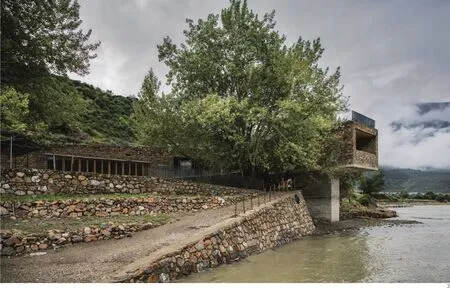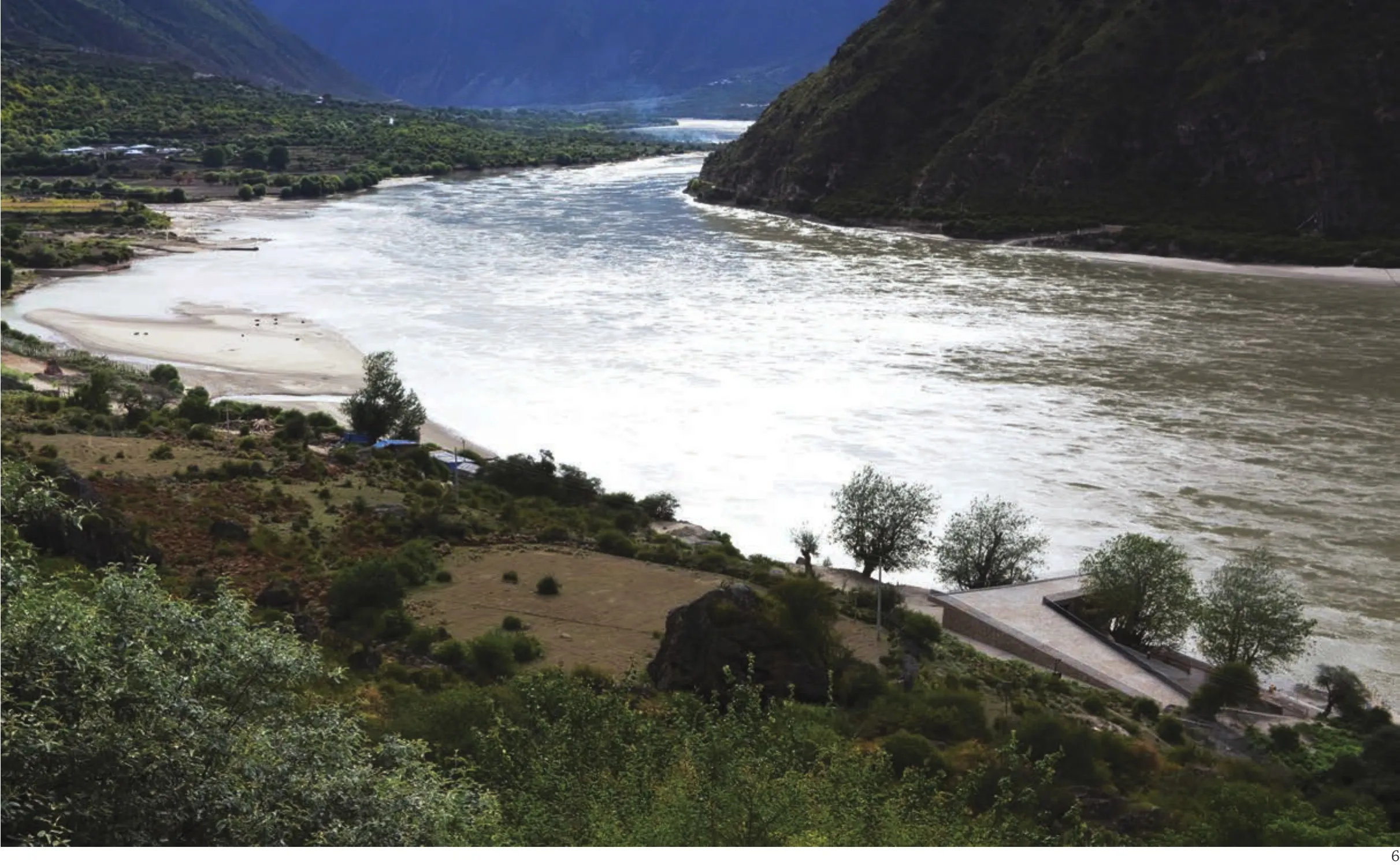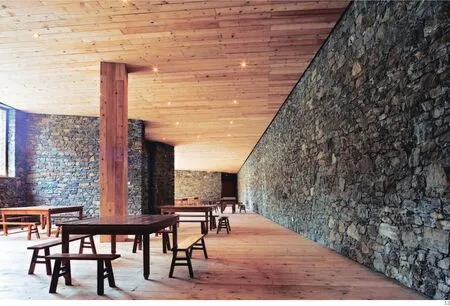雅鲁藏布江小码头,林芝,西藏,中国
2018-10-27建筑设计标准营造
建筑设计:标准营造
Architect: ZAO/standardarchitecture
小码头位于西藏雅鲁藏布大峡谷南迦巴瓦雪山脚下的派镇附近,派镇是林芝地区米林县的一个村级小镇,不仅是雅鲁藏布大峡谷的入口,还因为是通往全国唯一不通公路的墨脱县的陆路转运站而早就成为终极徒步旅行者的胜地。自从大峡谷被认定为世界第一大峡谷、中国国家地理杂志将其中海拔7782m的南迦巴瓦雪山选为“中国最美的山峰”之首,逐渐成为普通徒步旅行者的目的地。
设计是从地段的选择开始的。我们从派镇出发沿岸一路向下游方向寻找合适的位置,我们需要一块水流相对较缓同时有一定水深的河岸。走到大约2km外的江面拐弯处,我们一眼看中了这个位置,这里有形态特别的4棵胸径都超过1m的大杨树,旁边还有几块巨大的岩石,站在岩石上顺着江流的方向看过去,随时可以看到峡谷背后高耸的加拉白垒和南迦巴瓦雪山。
码头的规模很小,只有430m2,功能也很朴素,主要为水路往返的旅行者提供基本的休息、候船、卫生间及恶劣天气情况下临时过夜等功能。建筑是江边复杂地形的一部分,一条连续曲折的坡道,从江面开始沿岸向上,在几棵树之间曲折缠绕,坡道与两棵大树一起,围合成面向江面的小庭院,庭院由碎石铺成,可以供乘客休息观景。由庭院再向上,坡道先穿过上层坡道形成的一个挑空过道,经两次左转悬空越过自己,然后再次右转,并在高处从两棵大树之间穿出悬挑到江面上,成为一个飘在江面上的观景台。
码头的室内空间分为两部分,一块是候船厅,一块是售票室和守候人员临时卧室,分别利用地形和坡势,隐藏在坡道的下面。候船厅面对的是低一点的小庭院和两棵大杨树,厅内有供休息喝茶的条桌条凳和冬季烧火取暖的石头炉子,尽端是两个卫生间。售票室和临时卧室位于最高标高的坡道下面,是部分悬挑的部分,卧室外有木平台,从木平台上看出去有很好的视野,可以观察江面的船只情况和远处的加拉白垒雪山。
建筑的材料,从墙面到坡道的地面,全部是来自附近的石头,墙体的砌筑全部由当地工匠采用他们熟悉的方式完成,室外和室内都统一采用粗糙的石墙;门窗和室内的天花、地面自然是用当地松木以当地的方式在现场加工的。□
The small boat terminal is located near to the small village named Pai Town in the prefecture of Linzhi in Tibet Autonomous Region. As the remotest stop along the Yarlung Zangbo River, it allows both local people and travelers from outside to transport by water deep into the valley and come to the foot of the Namchabarwa Snow Mountain.
With a total area of only 430m2, the building programme is quite basic. It has a few toilets, a waiting lounge, a ticket office and a room for people to stay overnight in case the weather goes too fierce to travel on the river. The programmes are covered by a series of ramps rising from the water and winding around several big poplar trees, and ends up suspending over the water. Looking from a distance, the building is completely merged in the riverbank topography and becomes part of the greater landscape.
Construction materials are mainly local. All the walls and roofs are made of rocks collected from nearby. Walls are built by Tibetan masonry builders in their own pattern. Window and door frames,ceilings and floors are all made of local timber by a local method.□


1.2 外景/Exterior views



3 模型/Model
4.5 立面/Elevations
6 鸟瞰/Aerial view
7 外景/Exterior view



8 平面/Plan
9 剖面/Section
10 外景/Exterior view




11 外景/Exterior view
12 内景/Interior view
评论
王硕:2006年,标准营造开始为雅鲁藏布江河谷地区旅游产业进行一系列基础设施建筑的规划。这一系列项目的契机是林芝地区落成了一座机场。而随着雅鲁藏布江大峡谷被认定为“世界第一大峡谷”、南迦巴瓦雪山被选为“中国最美的山峰”之首,这里逐渐成为徒步旅行者的目的地。派镇作为整个雅鲁藏布江大峡谷景区的起始点,往下游不远处的小码头是张轲西藏系列建造的第一个,有着特别的开端意义。
整个建筑几乎就是由一条从河岸延升上来的连续而曲折的坡道定义而成的。顺着这条无尽折叠的坡道,可以从停靠的船舶开始,途经建筑两块基本的功能:候船厅和售票室,并从其间穿越而过,进而转身从坡道走上屋面越过自己的头顶……一路走来,仿佛布达拉宫前绵长曲折的台阶,在露台上望向同样蜿蜒盘旋的江面,建筑的存在反而不再是关注点。通过顺应地势的扭转倾斜,建筑很好地嵌入了周边的地形,与它背靠的山崖融为一体,包括建筑外立面所使用的本地石材、木材及本地工艺,都明确地指向了这一设计所采取的基本策略,即与周围的自然环境及文化由一种平视的角度谋求新的契合点。
平视并不等于平淡。整座建筑的体验中有两个“悬浮的时刻”,分别对应两个方向的到访者。第一个在来路方向建筑形体的锐角处,这里建筑被切削成很薄的悬挑;第二个则是连续坡道的尽端——面向江面悬挑而出的有阳台开口的眺望空间。这一悬浮的建筑体量与周边层叠厚重的挡土墙以及浓茂的山林产生了一种精巧的反差,从江中看去,小码头既融入环境又跳出背景。这不由让人想到罗伯特·史密森的“螺旋防波堤”,小码头仿佛一个随时要消失的地景标志建筑[1]——“Land(scape) Mark”,只在地景中留下一个轻巧的痕迹。
从“平视”的角度出发,藉由建造所呈现出来的“悬浮”感,小码头创造了新的形式逻辑,打破了藏区近年来形成的用新材料模仿藏族风格建筑的定式,不去破坏当地文化的本真。张轲所提出的介入策略,将关注点放在如何使“中国的当代性”这一新的时代价值最大化——通过削减重量,抬升到一种很轻的悬浮状态。这种悬浮,既是操作层面的,也是视觉层面的。从当代空间生产角度而言,他引出的实践方向具有双重穿透性。这些建筑物/空间在当地藏族人看来与传统不是同质化的,于本地建成环境而言有一种蜻蜓点水的跳脱感;而从旅行者来看,它又深刻地镶嵌在周边环境和文化中,仿佛是从地景中生长出来的“水晶”。
如果说标准营造第一个5年的实践实现了一种在中国多变的城市环境中对设计品质的“现代性”革新追求,那么从雅鲁藏布江小码头开始展开西藏系列实践的张轲,已经更加能够自由并打破“现代性”既定标准地来进行空间实践了。用他自己的话来说,已成为“标准的对立面,目标就是打破现有标准”。至此,张轲从具有“普遍性”的城市中跳转到更有“特定性”自然环境/文化传统的地区,并由此展开了一系列具有积极的“当代性” 意义的空间生产探索。
Comment
WANG Shuo:In the year 2006, ZAO/standardarchitecture began to plan a series of infrastructural buildings for the tourism industry in the valley area of Yarlung Zangbo River. The momentum for this series of projects is a result of a recently completed airport in Linzhi. Since the Yarlung Zangbo River Grand Canyon was recognised as the world's largest canyon, and the Namchabarwa Mountain chosen as the first among the "most beautiful peaks in China,"it has gradually become the hikers' destination. The little boat terminal not far downstream from Pai Town, the starting point of the whole scenic area of the Yarlung Zangbo River Grand Canyon, is the first of ZHANG Ke's Tibetan construction series, and has a special significance of inception.
The whole building is almost defined by a continuous zigzagged ramp extending and rising from the riverbank. Going from the anchored boats along this endlessly folding ramp, you can pass by the two basic function of the building: the waiting room and the ticket offce, and keep walking through them,turning around and meandering on the ramp over your head... all the way up like the long and interlaced steps in front of Potala Palace. When you're looking at the similar winding river from the terrace, the existence of the building itself becomes not the main focus. By adjusting to the twisting landform, the building is well embedded in the surrounding terrain and blends with the cliffs against its back. Together with all the local stone on the facade, the timber and local craftsmanship used in the construction of the building, it clearly point to the basic strategy of the design, which is to negotiate a new dialogue with the surrounding natural environment and culture from a point of view that is on the "eye-level".
Eye-level view does not mean bland. There are two "moments of levitation" in the building experience that react to visitors from two directions.The first one is at the sharp corner of the building in the direction of arrival, where the building is cut into a very thin overhang. The second is at the end of the continuous ramp – a lookout space reaching out towards the river with balcony openings. This"suspended" building volume forms a delicate contrast to the heavy layers of retaining walls and lush forests around it. Looking from the river, the boat terminal is both blending into the environment and standing out from the background. Reminding one of Robert Smithson's Spiral Jetty, the boat terminal is like a "Land(scape) Mark"[1]that's going to disappear at any moment, leaving only a light trace on the landscape.
Start from the point of view on the "eye-level",further constructed with the sense of "levitation",the boat terminal has created a new kind of form logic, breaking the formula of imitating Tibetan style architecture with new materials which has became stereotype in the Tibetan region in recent years, without destroying the authenticity of the local culture. The interventional strategy ZHANG Ke put forward focuses on how to maximise "Chinese contemporaneity", the value of the new era, by reducing "weight" and lifting up to a very light"levitation" state. This levitation is both operational and visual. From the perspective of contemporary production of space, the direction of practice he points out has cross-penetration. From the local Tibetans' point of view, these buildings/spaces are not homogeneous with the tradition, so there is a sense of leaping out from the local built environment like "dragonfly dipping on water"; and from the travellers' point of view, it is deeply embedded in the surrounding environment and culture, as if it's a"crystal" growing out of the landscape.
If it could be said that ZAO/standardarchitecture's first five years of practice has realised a"modernity" in the pursuit of innovation and design quality in flexible urban environment in China, then after from the Tibetan practices beginning with the Yarlung Zangbo River Boat Terminal, ZHANG Ke has become more free and able to break the established standards of "modernity" to carry out spatial practices. In his own words, he has become the "antithesis of standard, and the goal is to break the existing standards". So far, ZHANG Ke has jumped from the "generalized" city to regions with more "specificality" in natural environment/cultural tradition, and thus unfolded a series of exploration of active contemporary production of space.(Translated by CHEN Yuxiao)
注释/Note
[1] 地景标志建筑:笔者创造的一个词汇,用于描述一种特殊类型的建筑。地景标志建筑通常是小尺度的并且处于自然环境中。它与周边的地貌景观进行对话,并从中确立它的意义。它并不试图像“地标建筑”一样宏大/浮夸,但它确在地景中留下了轻巧的痕迹,并因此而成为一个充满意义的象征。/"Land(scape) Mark": A word that the writer coined to discribe a special typology of architecture. A "Land(scape) Mark" is usually small scale and sitting in a natural environment. While it is trying to be in dialogue with the surrounding landscape and defining its significance, it does not try to be as grandiose as a "landmark", yet it does leave an ethereal "mark" on the landform as a meaningful symbol.
